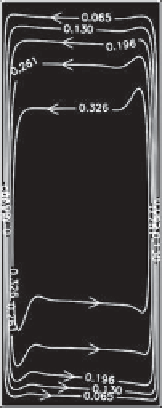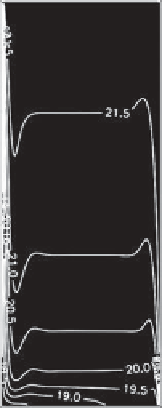Geoscience Reference
In-Depth Information
the presence of sloping boundaries and a much stronger
direct (spectrally nonlocal) upscale energy transfer into
the zonally symmetric component of the flow, in extreme
cases deforming the large-scale baroclinic zonal flow into
a pattern of multiple parallel jets and baroclinic zones.
Such patterns had been anticipated in several earlier stud-
ies [
Mason
, 1975;
Bastin and Read
, 1997, 1998], which
also noted the tendency to form flows with complex radial
structures, but these did not examine the energy exchanges
in such detail.
However, this whole subject area relating to energy
exchanges in geostrophically turbulent or chaotic flows
is substantially underexplored and deserves further inten-
sive study in future research. The respective roles of baro-
clinic and barotropic energy exchanges (both kinetic and
potential) remain uncertain in the general case, and how
such roles scale and vary with key control parameters
is virtually unknown. The study by
Wordsworth et al.
[2008] only considered quasi-barotropic energy exchanges
in detail in the cases they were able to measure, though
they attempted to infer some aspects of the baroclinic-
barotropic exchanges indirectly. But a more detailed study
utilizing combinations of velocity and temperature mea-
surements with good spatial coverage and high spatial
resolution are really needed to elucidate some of the
most challenging outstanding questions, that are currently
major issues for understanding the global circulation of
both the atmosphere and oceans [cf
SchneiderandWalker
,
2006;
Zurita-Gotor and Lindzen
, 2007;
Jansen and Ferrari
,
2012].
the complete adiabatic rearrangement of the fluid to
its lowest potential energy state is not sustainable but
results in a residual buoyancy-driven overturning circu-
lation, mainly confined to thin boundary layers adjacent
to the vertical boundaries (provided the Rayleigh num-
ber is large enough; see below). Figure 1.16 shows an
example from a numerical simulation of the equilibrated
flow in a nonrotating fluid annulus. This clearly shows
the temperature field assuming a bottom-heavy configura-
tion away from the vertical boundaries but with complex
thermal structure adjacent to the sidewalls as the tempera-
ture adjusts to the isothermal boundary conditions within
complex sidewall boundary layers. Some of this struc-
ture is associated with the strong overturning circulation
within the sidewall boundary layers, where conductive
heating/cooling is balanced by (mainly vertical) advection
of heat, with a return flow in the (quasi-inviscid) inte-
rior. The interior flow redistributes hot and cold fluid
until it reaches a state of minimum potential energy, i.e.,
with as much as possible of the cold dense fluid at the
bottom of the cavity. Hence, isotherms in the interior
become virtually horizontal and stably stratified in the
vertical, adjusting to become vertical in thin conduction-
dominated boundary layers adjacent to the sidewalls. In
this state, advective heat transport (by laminar flow) is
14
14
1.4. HEAT TRANSPORT AND ROLE
OF BAROCLINIC WAVES
It is often asserted [e.g.,
Hide and Mason
, 1975] that
baroclinic annulus waves develop from a baroclinically
unstable background state and serve primarily to transfer
heat upward and horizontally from hot regions toward
cooler ones. But heat transfer within the baroclinic rotat-
ing annulus is actually significantly more complicated
than this would suggest.
If the annulus were illed with a conducting solid instead
of a fluid, heat would only be transferred by molecular
conduction. Hence, with isothermal vertical boundaries
the equilibrated isotherms would lie on cylindrical sur-
faces coaxial with the axis of symmetry. Such a config-
uration in a fluid would be very unstable, however, since
large amounts of potential energy would be stored com-
pared with the lowest energy state that could be obtained
by an adiabatic rearrangement of the fluid to place the
denser fluid as low as possible (and vice versa). Where the
boundary temperatures are actively maintained, however,
0
0
2.5
8.0
2.5
8.0
Radius (cm)
Radius (cm)
Figure 1.16.
Numerical simulation of the equilibrated axisym-
metric flow in a rotating annulus experiment with sidewalls
maintained at different temperatures but with
=0:(a)
stream function for the meridional circulation in the
(r
,
z)
plane;
(b) corresponding temperature field with thin thermal boundary
layers adjacent to each sidewall.

















